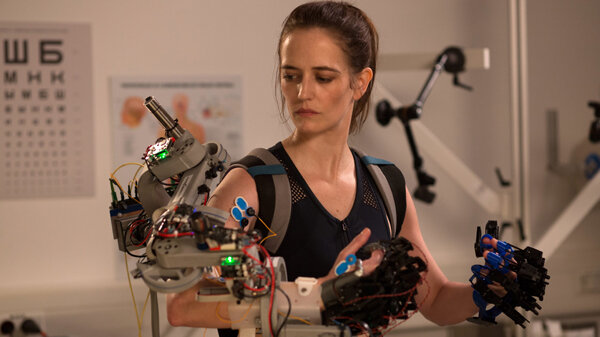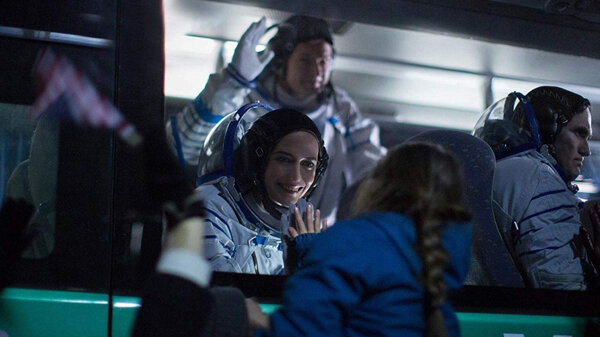Films about space often focus on men reaching for the moon, and have little concern for what happens before they get there. But Alice Winocour’s Proxima is different, looking at the relationship between a mother and her young daughter before she swaps motherhood for Mars. A grounded astronaut movie that knows about isolation and strength in unprecedented times: Anna Henschel writes on how Proxima helped her stay connected to her loved ones.
For as long as I can remember, I have been fascinated by space exploration. On warm summer nights of my childhood, my little sister and I would sit on the back porch and huddle together while our dad told us stories about the constellations. My heart was beating a little faster when I saw the Southern Cross for the first time. I was lying on the back of a car in the middle of nowhere, in Australia. When astronomers recently reported a mysterious flicker of one of the brightest stars in our night sky, a heated debate in our family WhatsApp group ensued – what was happening to Betelgeuse?
With the pandemic claiming almost every single one of our earthbound thoughts, my family chose to focus on the stars. When cinemas in the UK were finally opening their doors to small crowds of diehard cineastes, there was hardly any question which movie I was going to see. I read the name – Proxima (Latin for very close) – and the next moment I found myself in an eerily empty cinema. Going in, I was so nervous that I almost didn’t hear the usher, who gently asked me a second time to tear my own ticket. Sitting in a cinema and watching the movie through fogged-up glasses as I was breathing in and out of my mask was one of the most surreal experiences of my year. But I am so glad I went – this movie demands to be seen on a big screen, dreamy and uncanny all at once.
We never quite make it to space. Among its kind, the near-future space travel narratives, Proxima is singular. In this genre, we rarely see a realistic look at astronauts’ preparations for departure. We root for Mark Watney, when he is trapped on Mars and trying to “science” his way out of his desperate predicament in The Martian. We fear for Ryan Stone as she fights for survival in Gravity, after being hit by space debris and tumbling through space’s dark vacuum. But how did we get there in the first place? Who are these larger-than-life humans, showing nothing but reckless abandon for the idea of being confined to our close and familiar orbit? This is the question Proxima, by French screenwriter and director Alice Winocour, sets out to answer.
From the day Sarah hears that she was selected for the highly competitive European Space Agency mission Proxima (named after the real ESA mission on the ISS, with its crew member Thomas Pesquet making a cameo), we follow every step of quiet determination that brings Sarah closer towards her goal of being an astronaut. The opening sequence shows her with daughter Stella (Latin for star), practicing a well-known procedure: the bedtime routine. They countdown, until Sarah finally whispers “second-stage separation” and kisses her daughter goodnight. t
What initially attracted me to the film was the promise to forget the world for a while, to immerse myself in vast and empty outer space. But what made me fall in love with Proxima was its uncomfortable reality, its characters who sometimes struggle to find the right words, the fraught ties that bind Sarah to her ex-husband, and the complicated relationship with her daughter, who is not ready to let her go.
While Sarah is preparing for “the last mission before Mars”, she is sent off for training in Russia’s enigmatic Star City, to then to blast-off from the Baikonur Cosmodrome in Kazakhstan – all filmed on location.
The gruelling astronaut training is fascinating to watch: the vulnerable and otherworldly Eva Green is measured for her space suit, subsequently participating in arduous underwater rescue scenarios and gravitational acceleration tests, and at the end of the day patiently answering probing questions from journalists. No, her mother did not support her aspirations. “Women were not supposed to do these kinds of jobs,” she says.
The cinematography is very matter of fact, and many memorable images linger, owing to the contrast in hyper realistic scenes containing strange, fictitious-seeming elements – for example, when Stella wanders off from an event and stumbles into ESA’s lunar simulation, a little piece of the moon on planet Earth. Director of photography Georges Lechaptois uses wide shots that echo the stylish movies of Greek director Yorgos Lanthimos. Lanthimos’ cinematographer Thimios Bakatakis said about this distinct look: “The future has the same light as today”. Similarly, in Proxima, the near-future is only subtly referenced. With the many documentary-style images, we almost forget that the last mission before Mars still remains a distant goal. But Sarah emerges from a tranquil pond after a rocket-landing simulation in full space gear, we get a glimpse of this possible strange future.
At the centre of the film is the strong bond between mother and daughter. Sarah feels torn about pursuing her goals and leaving Stella behind. Eight-year-old Stella, who struggles with her maths homework and cannot seem to connect to children her age, is always overpowered by her exceptional mother. As Sarah slowly withdraws from her life, placing her in the care of her busy father, a physicist at ESA, an unexpected opportunity opens for Stella to explore who she is when separated from her mother.
A child of two astrophysicists, Stella struggles with dyslexia and dyscalculia. She uses her telescope not to look at the night sky, but to observe the neighbour’s children. Until the final moments, Stella does not fully appreciate her mother’s passion, which often borders on obsession. But in one of the film’s final scenes, mother and daughter escape from the mandated quarantine on the night before take-off, and march through the desert together. The moment they see the rocket glistening in the morning sun, Stella’s eyes light up. She can finally, if only for a short moment, understand her mother’s view of the world.
Sarah feels guilty for leaving her daughter behind, and struggles to preserve fragments of her femininity in a hyper-masculine environment. When she is welcomed in Star City, Sarah is reminded that “not many like her have come here before”. In the frozen-in-time accommodations, she watches old movies lying upside down on her bed to prepare for zero gravity. Only keeping in touch with Stella through video recordings, Sarah views from a distance how she learns how to cycle, ice skate, fall down and get back up again without her. With every day of astronaut training, she grows more desperate at the prospect of not being a part of Stella’s life for a whole year. When Sarah finally reaches a breaking point, her colleague (a convincingly gruff and misogynistic Matt Dillon) muses that there are no perfect mothers. Just as there are no perfect astronauts.
In a joint interview, Eva Green and retired French astronaut Claudie Haigneré reflect on the last scene of the movie. We see Sarah in the rocket, looking at a picture of Stella attached to a little mirror on the wrist of her space suit. This mirror is the only opportunity for the tightly buckled-in astronauts to witness their departure from earth. “This moment of separation – it's a moment not to be missed,” the former astronaut Claudie Haigneré says with a smile.
At its most fundamental level, Proxima asks how we can stay connected to our loved ones when we are faced with extraordinary circumstances. Being separated from my family during the pandemic has been challenging. There are no straightforward remedies, but maybe sharing news about celestial objects in a group chat is a good place to start.
Anna Henschel (@AnnaHenschel) is a PhD candidate at the University of Glasgow and an aspiring science writer. Currently, she is researching how we perceive and interact with robots. In her free time she takes every opportunity to visit her favourite cinema – the Glasgow Film Theatre.



